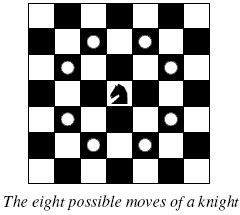A Knight's Journey
| Time Limit: 1000MS | Memory Limit: 65536K | |
| Total Submissions: 46639 | Accepted: 15875 |
Description
 Background
Background The knight is getting bored of seeing the same black and white squares again and again and has decided to make a journey
around the world. Whenever a knight moves, it is two squares in one direction and one square perpendicular to this. The world of a knight is the chessboard he is living on. Our knight lives on a chessboard that has a smaller area than a regular 8 * 8 board, but it is still rectangular. Can you help this adventurous knight to make travel plans?
Problem
Find a path such that the knight visits every square once. The knight can start and end on any square of the board.
Input
The input begins with a positive integer n in the first line. The following lines contain n test cases. Each test case consists of a single line with two positive integers p and q, such that 1 <= p * q <= 26. This represents a p * q chessboard, where p describes how many different square numbers 1, . . . , p exist, q describes how many different square letters exist. These are the first q letters of the Latin alphabet: A, . . .
Output
The output for every scenario begins with a line containing "Scenario #i:", where i is the number of the scenario starting at 1. Then print a single line containing the lexicographically first path that visits all squares of the chessboard with knight moves followed by an empty line. The path should be given on a single line by concatenating the names of the visited squares. Each square name consists of a capital letter followed by a number.
If no such path exist, you should output impossible on a single line.
If no such path exist, you should output impossible on a single line.
Sample Input
3 1 1 2 3 4 3
Sample Output
Scenario #1: A1 Scenario #2: impossible Scenario #3: A1B3C1A2B4C2A3B1C3A4B2C4
题目大意:给你N组数据,输入N组p,q,p代表棋盘的行数,q代表棋盘的列数。任选一个起点,按照国际象棋马的跳法,不重复的跳完整个棋盘,如果有多种路线则选择字典序最小的路线(路线是点的横纵坐标的集合,注意棋盘的横坐标的用大写字母,纵坐标是数字)
题目分析:
1. 应该看到这个题就可以想到用DFS,当首先要明白这个题的意思是能否只走一遍(不回头不重复)将整个地图走完,而普通的深度优先搜索是一直走,走不通之后沿路返回到某处继续深搜。所以这个题要用到的回溯思想,如果不重复走一遍就走完了,做一个标记,算法停止;否则在某种DFS下走到某一步时按马跳的规则无路可走而棋盘还有为走到的点,这样我们就需要撤消这一步,进而尝试其他的路线(当然其他的路线也可能导致撤销),而所谓撤销这一步就是在递归深搜返回时重置该点,以便在当前路线走一遍行不通换另一种路线时,该点的状态是未访问过的,而不是像普通的DFS当作已经访问了。
2. 如果有多种方式可以不重复走一遍的走完,需要输出按字典序最小的路径,而注意到国际象棋的棋盘是列为字母,行为数字,如果能够不回头走一遍的走完,一定会经过A1点,所以我们应该从A1开始搜索,以确保之后得到的路径字典序是最小的(也就是说如果路径不以A1开始,该路径一定不是字典序最小路径),而且我们应该确保优先选择的方向是字典序最小的方向,这样我们最先得到的路径就是字典序最小的。
#include<iostream>
#include<stdio.h>
#include<string.h>
using namespace std;
int vis[27][27];
int dir[9][2]={0,0,-1,-2,1,-2,-2,-1,2,-1,-2,1,2,1,-1,2,1,2};
int x,y;
bool flag=false;
struct node
{
int x,y;
}path[27];
bool check(int x1,int y1)
{
if(x1<1||x1>x||y1<1||y1>y||flag==true||vis[x1][y1]==1) return false;
else return true;
}
void DFS(int x0,int y0,int num)
{
int i;
path[num].x=x0,path[num].y=y0;
//printf("x0y0:%d %d %d\n",x0,y0,vis[x0][y0]);
if(num==x*y) {flag=true;return ;}
for(i=1;i<=8;i++)
{
int x1=x0+dir[i][0],y1=y0+dir[i][1];
if(check(x1,y1))
{
vis[x1][y1]=1;
DFS(x1,y1,num+1);
vis[x1][y1]=0;//回溯
}
}
}
int main()
{
int n,i;
char c;
scanf("%d",&n);
for(i=1;i<=n;i++)
{
flag=false;
memset(vis,0,sizeof(vis));
scanf("%d %d",&x,&y);
vis[1][1]=1;
DFS(1,1,1);
if(flag==false) printf("Scenario #%d:\nimpossible\n",i);
else
{
printf("Scenario #%d:\n",i);
for(int j=1;j<=x*y;j++)
{
printf("%c%d",path[j].y+64,path[j].x);
}
printf("\n");
}
if(i!=n) printf("\n");
}
return 0;
}
版权声明:本文为anan15151529原创文章,遵循CC 4.0 BY-SA版权协议,转载请附上原文出处链接和本声明。